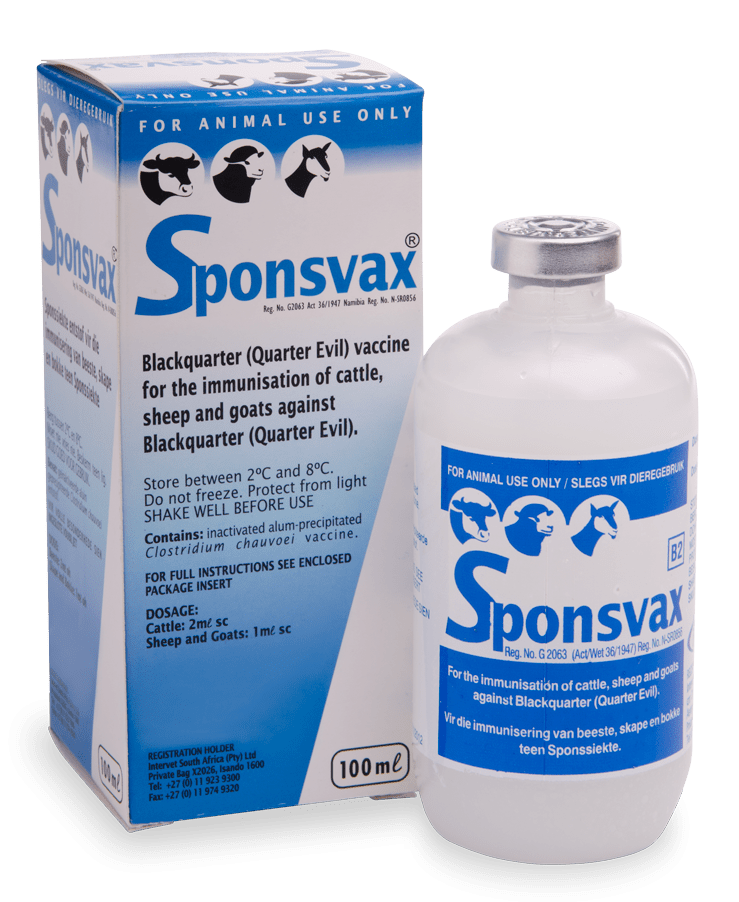Sponsvax®
For the immunisation of cattle, sheep and goats against black quarter (Quarter Evil).

FOR ANIMAL USE ONLY
SPONSVAX®
Reg. No. G2063 (Act 36/1947)
Namibia Reg. No. V95/24.4/496 [NS0]
INDICATIONS
For the immunisation of cattle, sheep and goats against black quarter (quarter evil).
COMPOSITION
Contains inactivated alum-precipitated Clostridium chauvoei anacultures.
STORAGE
- Store between 2 ºC and 8 ºC.
- Do not freeze.
- Protect from light.
WARNINGS
- The inoculation of animals late in pregnancy should be avoided unless there is a serious risk of disease.
- As with all vaccines occasional hypersensitivity reactions may occur. In such cases appropriate treatment such as adrenaline and/or antihistamines should be administered without delay.
- Usually, no marked reaction follows vaccination although a transient swelling may appear at the site of inoculation and an animal may show a rise of temperature for 1 or 2 days.
- Dispose of any unused vaccine as well as all empty vaccine containers and vaccination equipment according to local waste disposal regulations.
- KEEP OUT OF REACH OF CHILDREN, UNINFORMED PERSONS AND ANIMALS.
- Although this vaccine has been extensively tested under a large variety of conditions, failure thereof may ensue as a result of a wide range of reasons. If this is suspected, seek veterinary advice and notify the registration holder.
Note: Although Clostridium chauvoei is the most common cause of black quarter (quarter evil), other clostridia (C. septicum and C. novyi) can cause a similar condition. If problems are encountered in vaccinated animals, a veterinarian should be consulted so that a definite diagnosis can be made.
DIRECTIONS FOR USE – USE ONLY AS DIRECTED
Shake well before and during use.
DOSAGE
Administration by subcutaneous injection only.
Cattle: 2 mℓ subcutaneously (SC).
Sheep:1 mℓ subcutaneously (SC).
Goats: 1 mℓ subcutaneously (SC), in the loose skin under the tail.
Cattle
Cattle should first be vaccinated between 3 and 6 months of age. Two subcutaneous injections of 2 mℓ each must be administered at an interval of 4 weeks and an annual booster injection should be given until the animals are 3 years old.
In areas where animals are likely to be subjected to continued exposure to infection, vaccination every 6 months may be advisable.
Under normal conditions, annual revaccination will usually suffice.
A separate sterile needle must be used for each animal, especially during an active outbreak. If this is not done, cross infection can occur from an animal which is in the incubation stage of the disease and the whole herd may become infected.
Care should also be taken not to inject the vaccine intramuscularly.
Sheep
Sheep should first be vaccinated at 2 months of age. Two subcutaneous injections of 1 mℓ each must be administered at an interval of 4 weeks and an annual booster thereafter.
In areas where the practice is to vaccinate lambs younger than 2 months, a second booster vaccination will be required 3 to 4 weeks later.
Annual vaccination should be given 4 to 6 weeks before any operation likely to produce wounds (lambing, tail docking, castration, shearing, etc.).
Goats
These are similar to those for sheep, however, consultation with a veterinarian is advisable before vaccination.
Goats should be vaccinated in the loose skin under the tail. Do not vaccinate goats in the neck.
PRESENTATION
Sponsvax® is a colourless liquid with an off-white precipitate which resuspends on shaking.
100 mℓ polipropylene containers capped with synthetic rubber stoppers and aluminium seals. (Cattle 50 doses and sheep/goats 100 doses).
REGISTRATION HOLDER
Intervet South Africa (Pty) Ltd.
20 Spartan Road, Spartan
1619, RSA
Tel: +27 (0) 11 923 9300
E-mail: msdahza@msd.com
www.msd-animal-health.co.za
DATE OF PUBLICATION OF THIS PACKAGE INSERT
1 November 2016
| Zimbabwe Reg. No.: 88/80.23.10/9225 Pharmacological Classification: 80.23.10 vaccines Category for Distribution: VMGD |
